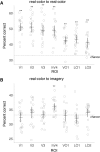Human V4 Activity Patterns Predict Behavioral Performance in Imagery of Object Color
- PMID: 29519852
- PMCID: PMC6705916
- DOI: 10.1523/JNEUROSCI.2307-17.2018
Human V4 Activity Patterns Predict Behavioral Performance in Imagery of Object Color
Abstract
Color is special among basic visual features in that it can form a defining part of objects that are engrained in our memory. Whereas most neuroimaging research on human color vision has focused on responses related to external stimulation, the present study investigated how sensory-driven color vision is linked to subjective color perception induced by object imagery. We recorded fMRI activity in male and female volunteers during viewing of abstract color stimuli that were red, green, or yellow in half of the runs. In the other half we asked them to produce mental images of colored, meaningful objects (such as tomato, grapes, banana) corresponding to the same three color categories. Although physically presented color could be decoded from all retinotopically mapped visual areas, only hV4 allowed predicting colors of imagined objects when classifiers were trained on responses to physical colors. Importantly, only neural signal in hV4 was predictive of behavioral performance in the color judgment task on a trial-by-trial basis. The commonality between neural representations of sensory-driven and imagined object color and the behavioral link to neural representations in hV4 identifies area hV4 as a perceptual hub linking externally triggered color vision with color in self-generated object imagery.SIGNIFICANCE STATEMENT Humans experience color not only when visually exploring the outside world, but also in the absence of visual input, for example when remembering, dreaming, and during imagery. It is not known where neural codes for sensory-driven and internally generated hue converge. In the current study we evoked matching subjective color percepts, one driven by physically presented color stimuli, the other by internally generated color imagery. This allowed us to identify area hV4 as the only site where neural codes of corresponding subjective color perception converged regardless of its origin. Color codes in hV4 also predicted behavioral performance in an imagery task, suggesting it forms a perceptual hub for color perception.
Keywords: color vision; drift diffusion; fMRI; object imagery; pattern classification; reaction times.
Copyright © 2018 the authors 0270-6474/18/383657-12$15.00/0.
Figures





Similar articles
-
Decoding the yellow of a gray banana.Curr Biol. 2013 Nov 18;23(22):2268-2272. doi: 10.1016/j.cub.2013.09.016. Epub 2013 Oct 31. Curr Biol. 2013. PMID: 24184103
-
Disentangling visual imagery and perception of real-world objects.Neuroimage. 2012 Feb 15;59(4):4064-73. doi: 10.1016/j.neuroimage.2011.10.055. Epub 2011 Oct 24. Neuroimage. 2012. PMID: 22040738 Free PMC article.
-
Prior Knowledge about Objects Determines Neural Color Representation in Human Visual Cortex.Cereb Cortex. 2016 Apr;26(4):1401-1408. doi: 10.1093/cercor/bhu224. Epub 2014 Oct 16. Cereb Cortex. 2016. PMID: 25323417
-
Shared Neural Mechanisms of Visual Perception and Imagery.Trends Cogn Sci. 2019 May;23(5):423-434. doi: 10.1016/j.tics.2019.02.004. Epub 2019 Mar 12. Trends Cogn Sci. 2019. PMID: 30876729 Review.
-
The relationship between visual perception and visual mental imagery: a reappraisal of the neuropsychological evidence.Cortex. 2002 Jun;38(3):357-78. doi: 10.1016/s0010-9452(08)70665-8. Cortex. 2002. PMID: 12146661 Review.
Cited by
-
The color of fruits in photographs and still life paintings.J Vis. 2024 May 1;24(5):1. doi: 10.1167/jov.24.5.1. J Vis. 2024. PMID: 38691088 Free PMC article.
-
Object color knowledge representation occurs in the macaque brain despite the absence of a developed language system.PLoS Biol. 2024 Oct 28;22(10):e3002863. doi: 10.1371/journal.pbio.3002863. eCollection 2024 Oct. PLoS Biol. 2024. PMID: 39466847 Free PMC article.
-
Stochastic resonance model of synaesthesia.Philos Trans R Soc Lond B Biol Sci. 2019 Dec 9;374(1787):20190029. doi: 10.1098/rstb.2019.0029. Epub 2019 Oct 21. Philos Trans R Soc Lond B Biol Sci. 2019. PMID: 31630652 Free PMC article. Review.
-
Temporal dynamics of the neural representation of hue and luminance polarity.Nat Commun. 2022 Feb 3;13(1):661. doi: 10.1038/s41467-022-28249-0. Nat Commun. 2022. PMID: 35115511 Free PMC article.
-
Structural Differences Across Multiple Visual Cortical Regions in the Absence of Cone Function in Congenital Achromatopsia.Front Neurosci. 2021 Oct 14;15:718958. doi: 10.3389/fnins.2021.718958. eCollection 2021. Front Neurosci. 2021. PMID: 34720857 Free PMC article.
References
Publication types
MeSH terms
LinkOut - more resources
Full Text Sources
Other Literature Sources
